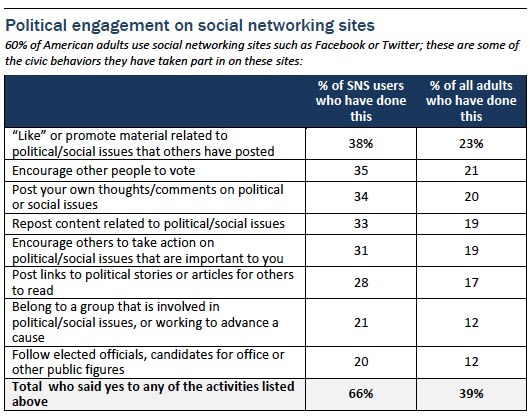The Pew Research Center’ Internet & American Life Project announced two potentially interrelated studies focusing on civic engagement and library usage.
In its study of Civic Engagement in the Digital Age, it found a significant increase in the use of social media as the method for civic engagement. Pew reports that 39% of American adults have recently contacted a government official or spoken out in a public forum. In addition, an even larger percentage, 48%, participate through some civic group or activity. The definition of civic activity is quite generous and inclusive:
 In this survey, the Pew Research Center’s Internet & American Life Project measured several broad categories of civic activity that Americans might engage in. The first finding is that half (48%) of American adults directly took part in a civic group or activity in the 12 months preceding our August 2012 survey. This includes anyone who did one or more of the following six activities:
In this survey, the Pew Research Center’s Internet & American Life Project measured several broad categories of civic activity that Americans might engage in. The first finding is that half (48%) of American adults directly took part in a civic group or activity in the 12 months preceding our August 2012 survey. This includes anyone who did one or more of the following six activities:
- 35% of American adults have recently worked with fellow citizens to solve a problem in their community
- 22% have attended a political meeting on local, town, or school affairs
- 13% have been an active member of a group that tries to influence the public or government
- 10% have attended a political rally or speech
- 7% have worked or volunteered for a political party or candidate
- 6% have attended an organized protest
Not surprisingly, the growth of social media had driven an increasing percentage of the public to use these tools. Pew provided a chart showing the engagement using social media is often the tool to engage with politicians and civic issues:
While social media has become increasingly important, it has not displaced real-world environments for civic interaction and engagement. A second study found that “94% of parents say libraries are important for their children.” 84% of parents with children under 8 say libraries are “very important.” The importance and actual usage of libraries declines for non-parent adults.
Unlike the social media study, however, libraries are more important to those with lower median incomes, because of the resources the libraries provide. Moreover, libraries have become a critical component of the social media landscape because of the computer and technology services they host.
Since reference services and non-lending activities at libraries remain an important factor for libraries, the future of libraries is not all bad. At the same time, however, even for adults with children, 81% borrowed books compared to the 9% who borrowed e-books. Literacy programs and coordination with schools remains an important part of what libraries do.
The two studies also suggests that as libraries reduce their emphasis on physical book collections as e-book lending grows, they can add soft-seating space and serve as a physical home for the growing civic engagement; a place home to both the public and the technology that will make it a natural focus for community building.
Comments from library staff involved in the survey identified many of these trends. Here are only a few:
“We’re definitely an important social place for many groups — children after school, the elderly and retired, job seekers, parents with children. I don’t think we can be just an online presence. Our physical space means a lot to people in our town.”
“The library should be a community center, safe and welcoming for all ages. There should be activities for young families, for young adults (e.g. actual adults, in their twenties), for teens and children who are not involved in a dozen different sports. As one patron said during our book sale/Girl Scout costume swap/high school bake sale/community farm sale—the library was “the place to be.””
“I’m more in favor of blended zones as opposed to separate spaces for different services. Having worked with very diverse clienteles, I found that everyone behaved better in a wider “village” concept. Preschool children aren’t any louder than the senior citizen book club who discuss their ailments and issues in very loud voices in the library. When I was a branch manager, the more furniture and shelving I took out of the branch, the happier the customers were — we only needed many more plug-ins for people to use.”
Of all the information gathered from both surveys, this thought perhaps sums up the potential best –
“Libraries—especially public libraries—should be the great connector. Connecting people with information and the resources they need to make informed decisions about their lives. Connecting people with the resources they need for entertainment. Connecting children to books and the love of reading. Connecting people to their roots and their past.”
Together, civic engagement and civic spaces will continue to thrive both online and in person so long as we as a society invest in what matters most. As always, the children will lead.
The full report on civic engagement is available here.
The full report on libraries – “Parents, Children, Libraries, and Reading” is available here.


